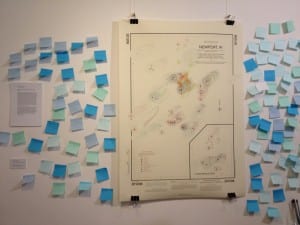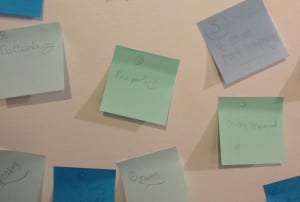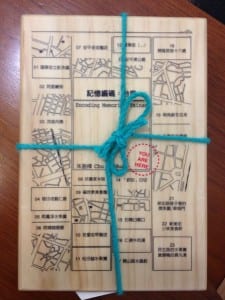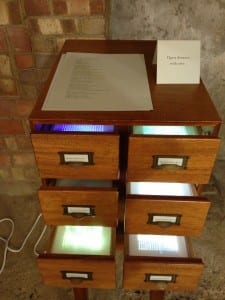‘Does smell make you nostalgic?’ Nostalgias exhibition, Margate Pie Factory
By uclfecd, on 13 November 2013
Following on from my previous post about Kate McLean’s wonderful smell maps, on Friday I went down to Margate to see one of them for myself! Her map ‘Summer Aromas of Newport, RI’ was one of the exhibits at Margate Pie Factory’s Nostalgias exhibition (1-12 November), held in conjunction with Canterbury Christ Church University and The University of the Arts London’s Nostalgias: Visualising Longing conference, and offered a delightfully (and sometimes stinkily) aromatic tour of the New England harbour town.
So, what does Newport, Rhode Island, smell like? According to Kate McLean, it’s a mixture of the sea, juniper bushes, lobster bait, ice-cream, freshly-cut timber and beach roses, amongst other things. But visitors to the exhibition didn’t have to take her word for it. The various scents of the seaside town were arrayed on a table in tiny medicinal, Bristol-blue glass bottles, like eccentric phials of perfume; visitors were invited to sniff each bottle, decide what it smelled like, write it on a Post-It note and stick it on the wall. Responses ranged from precise attempts to pinpoint the scent to the highly idiosyncratic: smell no. 3, for example, which had a fresh, fishy tang of the ocean, was variously described as ‘Margate today’, ‘the harbour’, ‘school science lab test tubes’, and even ‘at school, pencil sharpenings’. In the middle of the sea of mint, teal and powder-blue Post-It notes was Kate’s own ‘smell map’ of Newport. This showed the sources, range and intensity of the different scents, illustrated by colour-coded circles (for the sources) and wavy contour lines (for the range) on a parchment-cream background, like some dreamlike oceanographer’s chart. The whole exhibit was extremely visually (and nasally) appealing, mapping – and literally bottling – an aspect of landscape which is often both almost imperceptible and wordlessly accepted without further analysis.
Although Nostalgias didn’t focus explicitly on maps, in their different ways all the artists in the show used mapping as a way of exploring nostalgia for places, constructing their own private maps of different geographical areas. For instance, Chu YinHua’s Encoding Memories: Tainan traced the streets of the Taiwanese town by collecting stories about the different foods for sale there, recording these in a beautiful, woodcut-precise book of mingled street maps and stories. Meanwhile, A Collected History of Light by Michaela French was a luminous curiosity cabinet of a sculpture, capturing the precise colours of daylight from various locations and storing each one, fixed and unblinking, in the lightbulb-lined drawers of an old-fashioned wooden card catalogue.
From specimen drawers of light to bottled lobster bait, Nostalgias explored ways of distilling, fixing and categorising memories of places, whilst recognising the flickering subjectivity of these nostalgic reflections. As exercises in mapping, the guided routes into real or imagined pasts offered by the various exhibits were frequently beautiful, occasionally whiffy, and invariably intriguing.
 Close
Close









